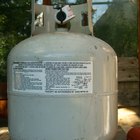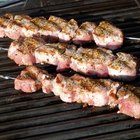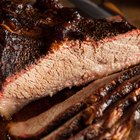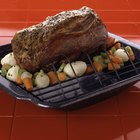
Cooking meat slowly at low temperatures causes the fat and connective tissue in the meat to melt and become tender -- perfect for stews, soups and pulled pork. If you're accustomed to cooking beef to anything less than well-done, the temperatures achieved with this method may surprise you. To fully tenderize slow-cooked meat, cook it until a meat thermometer reads at least 160 degrees F, and as high as as 195 F.
Why It Works
If you're looking for moist, tender results, slow cooking meat is the way to go. Cooking meat at low temperatures causes less moisture loss than roasting meat at high heat. The "low and slow" method also tends to cook meat more evenly. If you roast a cut of beef on high heat, the outside develops a crisp, golden crust, while the inside cooks much more slowly. By cooking for a long time at low heat, the entire cut of meat achieves the same degree of doneness. This approach is especially effective for tough cuts of meat, such as beef shoulder, round or leg, as well as for most pork roasts. These cuts usually contain more connective tissue, which remains tough unless it's cooked slowly. When very slowly cooked, meats and poultry release enzymes that tenderize even further.
Dry-Heat Methods
To slow roast pork or beef, preheat the oven to 225 to 300 F, according to Molly Stevens, author of "All About Roasting." Season the meat well and cook for between two and six hours, depending on the size of the cut and the tenderness desired. The meat is done when it's fork tender and almost falling apart. A meat thermometer inserted in the thickest portion of the meat should read at least 160 F. To cook pork roast slowly on the grill, soak wood chips in water and place them on aluminum foil. Fold the aluminum foil to make a packet. In the meantime, heat the grill to 225 or 300 F, leaving at least one burner off. Place the meat over the cool burner so it receives only indirect heat. Cook it for three to six hours, or until it's tender and a meat thermometer inserted in the roast reads 195 F.
Moist-Heat Methods
For even moister results, braise meats at low temperatures. First brown the meat in a roasting pan, which improves the texture and flavor. Scrape the bits of meat from the bottom of the pan and add liquid, such as wine, broth or juice until the meat is partially covered. Cover the roasting pan with a lid or foil and cook in an oven set at 275 F for three hours. You can also braise meat on the stove top for several hours or in a slow cooker on low for six to eight hours.
Potential Pitfalls
Braise or slow-roast beef, chicken and pork anytime you want falling-off-the-bone tenderness, particularly if you're using tough cuts of meat. Remember, however, that these methods won't give meat the golden brown sear that grilling or roasting at high temperatures impart. High-heat methods are the better choice for steaks, roasted chicken and tender beef roasts.
Related Articles

How to Cook a Beef Roast in a Roaster ...
How to Cook Boneless Top Chuck Steak in ...
How to Slow Cook a Pot Roast With Beef ...
How to Cook a Center Cut Sirloin of ...

How to Barbeque a Brisket on a Gas Grill

How to Cook London Broil

How to Cook a 15-Pound Rib Roast

How to Cook Beef in a Toaster Oven

How to Make a Blackbuck Antelope Roast

Easy Ways to Cook Pork Steak

How to Cook Pork Loin

How to Steam a Brisket of Beef

How to BBQ the Eye of Round Roast

How to Make Pan-Seared Baked Steak

How to Use Wood Chips in a Smoker

How to Marinate a Top Round Roast

Calories in Beef Rump Roast

How to Cook a Standing Rib With the ...

How to Cook Texas Broil Roast

Different Ways to Cook Chuck Roast Beef
References
Writer Bio
Julie Christensen is a food writer, caterer, and mom-chef. She's the creator of MarmaladeMom.org, dedicated to family fun and delicious food, and released a book titled "More Than Pot Roast: Fast, Fresh Slow Cooker Recipes."
Photo Credits
Eising/Photodisc/Getty Images